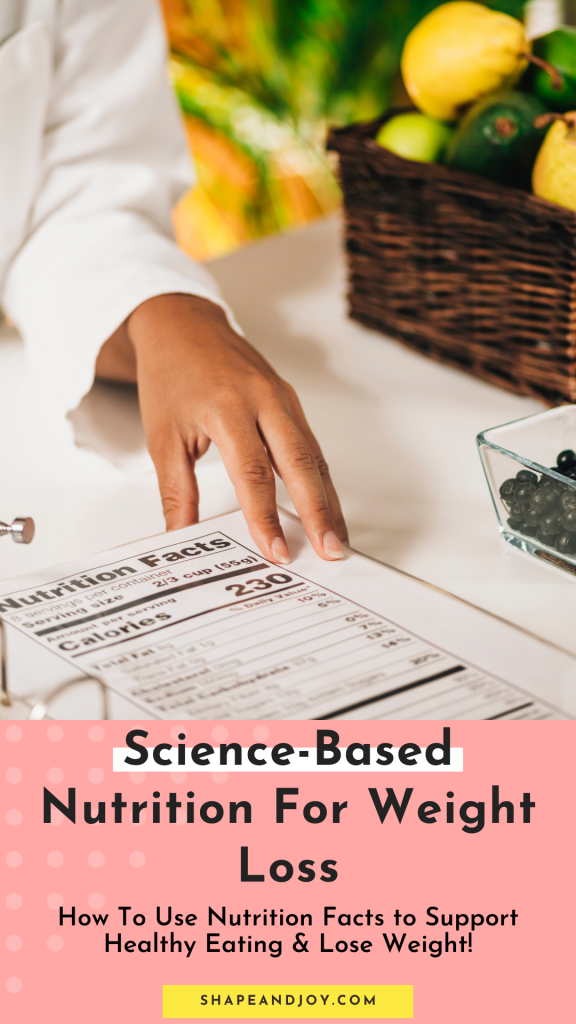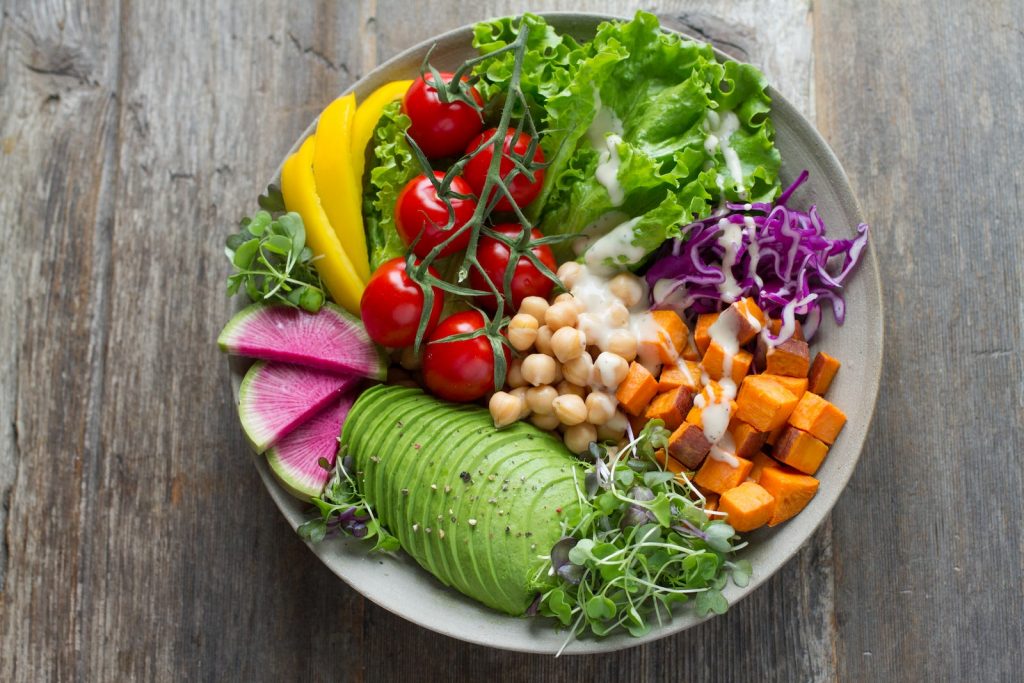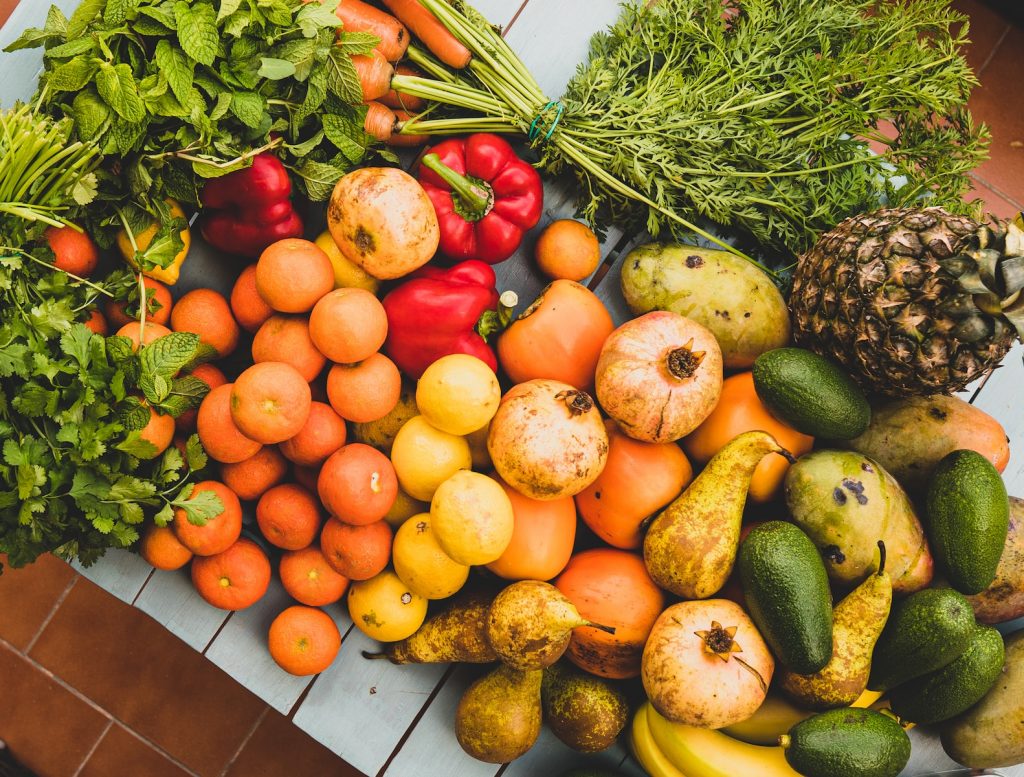This post may contain affiliate links, which means that I may earn a commission if you click on the link, with no cost for you. It’s one of the ways I support my blog. You can read more about this here.
Introduction
Have you found yourself lost in the sea of weight loss nutrition advice? Navigating the world of nutrition can feel like solving a puzzle, with countless pieces and conflicting advice. You start on your weight loss journey by following the latest diet trend, only to find that it doesn’t quite deliver the promised results. Before you know it, you’re pulled in another direction by a new approach that claims to be the key to effortless weight loss. The cycle repeats, and you’re left feeling like you’re trapped in a maze of contradictory information. In this post, I want to talk about approaching weight loss with science-based nutrition strategies.
LEARN MORE ABOUT MY WEIGHT LOSS JOURNEY! > How I Lost Over 80lbs: Tips For Starting A Weight Loss Journey

1. Prioritize Nutrient Density
When on a diet, we often focus on the energy density of food i.e. how many calories a food has. But it’s not just about counting calories; it’s about making every calorie count. Nutrient density on the other hand is the concentration of essential vitamins and minerals relative to its calorie content.
To lose weight you need to burn more calories than you eat, so why does nutrient density matter?
Nutrient-dense foods are usually more satisfying and can help control hunger. When you prioritize nutrient density, you’re making each calorie count by choosing foods that keep you fuller for longer. This can lead to reduced overall calorie intake without sacrificing satiety.
The science behind prioritizing nutrient density in weight loss is grounded in the understanding of how different nutrients impact the body’s physiology and metabolism.

Examples of How Nutrient Density Can Affect Weight Loss
- Hormonal Regulation: Nutrient-dense foods play a role in regulating hormones that influence hunger and satiety. For example, fibre, like from fruits and vegetables, slows down digestion and promotes a feeling of fullness. Hormones like leptin and ghrelin, which control appetite and are responsible for weight management, respond positively to nutrient-dense, fibre-rich meals, helping to manage caloric intake. Both my FREE Nutrition for Weight Loss eBook and my Complete Weight Loss Guide go into more detail about leptin and ghrelin, eating for satiety and more science-based nutrition advice.
- Metabolic Efficiency: Your body requires energy to digest, absorb, and utilize nutrients from food. This is known as the thermic effect of food (TEF). Protein has the highest TEF among macronutrients, requiring more energy for digestion and metabolism. By choosing foods high in protein, you can increase calorie expenditure through TEF. Which can contribute to a more efficient metabolism.
- Blood Sugar Regulation: Highly processed and refined foods, that are lacking in nutrient density, can lead to rapid spikes and crashes in blood sugar levels. These fluctuations can trigger feelings of hunger, leading to overeating and cravings for more sugary or high-calorie foods. Nutrient-dense choices contribute to more stable blood sugar levels, reducing the likelihood of these swings.

Examples of Nutrient Dense Foods
- Kale: Rich in vitamins A, C, and K, as well as folate and minerals like calcium and potassium.
- Salmon: A great source of omega-3 fatty acids, high-quality protein, vitamin D, and B vitamins. It also provides essential minerals like selenium (great for your skin!)
- Blueberries: Full of antioxidants, vitamins C and K, as well as fibre.
- Quinoa: Quinoa is a complete protein, providing all essential amino acids. It’s also high in fibre, magnesium and iron.
- Sweet Potatoes: A nutrient-dense source of complex carbohydrates, fibre, and beta-carotene, which converts to vitamin A in the body.
- Almonds: A good source of healthy fats, protein, and vitamin E. They also contain minerals like magnesium and potassium.
- Broccoli: High in vitamins C and K. It also provides fibre, folate, and antioxidants.
- Eggs: Eggs are another complete protein source and contain vitamin B12, choline, and selenium.
- Greek Yogurt: Rich in protein, calcium, and probiotics, supporting gut health.
- Spinach: Full of vitamins A and K, iron, and folate.
Including nutrient-dense foods in your diet will not only boost satiety but will help ensure that you’re still getting essential nutrients while cutting calories.
2. Balanced Macronutrients
What are Macronutrients?
- Carbohydrates: Carbohydrates are the body’s main source of energy. They are broken down into glucose, which is then used by cells for fuel. Carbohydrates include simple sugars (like glucose and fructose) and complex carbohydrates (like starch and fibre). They are found in foods like fruits, vegetables, grains, and legumes.
- Proteins: Proteins are crucial for building and repairing tissues, as well as for the production of enzymes, hormones, and other molecules in your body. Proteins are made up of amino acids, and there are essential and non-essential amino acids that the body needs. Sources of protein include meat, poultry, fish, eggs, dairy products, legumes, nuts, and seeds.
- Fats: Fats play an important role in energy storage, cell structure, and the absorption of fat-soluble vitamins (A, D, E, K). There are different types of fats, including saturated fats, unsaturated fats (monounsaturated and polyunsaturated), and trans fats. Healthy sources of fats (unsaturated) include avocados, nuts, seeds, olive oil, fatty fish, and certain plant oils.
Each macronutrient plays a unique role in supporting bodily functions. Finding the right balance contributes not only to your overall well-being but also to effective weight management.
Examples of How Macronutrient Balance Can Affect Weight Loss

- Steady Energy Release: A balanced intake of carbs, proteins, and fats provides a steady release of energy throughout the day. Carbohydrates fuel immediate energy needs, while proteins and fats contribute to sustained energy, preventing energy crashes.
- Enhanced Metabolism: Proteins have a higher thermic effect (Going back to TEF), and so require more energy for digestion. Making sure you eat enough protein may slightly boost metabolism because of this.
- Improved Satiety: A well-balanced meal can help regulate hunger hormones (leptin & ghrelin), promote a feeling of fullness and reduce the chances of overeating. Protein and healthy fats, especially, contribute to increased satiety.
- Muscle Preservation: Eating enough protein is essential for maintaining muscle mass during weight loss. And muscle requires more energy than fat to be maintained, which can help prevent metabolic adaptation.
Ideal Macronutrient Split For Weight Loss
There isn’t a one-size-fits-all answer to the ideal macronutrient intake for weight loss because we’re all different and it varies based on factors like age, gender, and activity levels. But a balanced approach for weight loss would fit into the below ranges:
- Carbs: 45–65%
- Proteins: 10–35%
- Fats: 20–35%
It’s up to you to tweak how much of each you want to include. You might start with 60% carbs but find you are not feeling full between meals. So it would be a good idea to decrease carbs and increase protein and/or fat to see if it makes a difference. Keep tweaking it until you find a good balance.
When it comes to sustainable health, looking at the big picture of nutrition makes all the difference. If you’re interested in an approach that’s both nourishing and realistic, check out my guide to holistic nutrition for a well-rounded take on eating.
3. Practice Mindful Eating Along With Science-Based Nutrition

In the hustle and bustle of modern life, mealtimes can become a rushed or secondary activity. This is where mindful eating comes in. Mindful eating is simply paying full attention to what you’re eating, savouring each bite without distraction.
The science behind mindful eating is rooted in the principles of mindfulness and its effects on both the physiological and psychological sides of eating. Several scientific studies have explored the impact of mindful eating on various aspects of health, including weight management.
Why Mindful Eating is Part of Science-Based Nutrition
Practicing mindful eating is not just a trend or fad; it has a solid foundation in scientific understanding. Here are several reasons why mindful eating is considered part of science-based nutrition:
- Stress Response and Digestion: By reducing stress during meals through mindfulness, the body is better able to digest food and absorb nutrients efficiently.
- Hormonal Regulation: Mindful eating has been associated with improved hormonal regulation, particularly with hormones related to hunger and satiety (Leptin and ghrelin again!)
- Mind-Body Connection: Mindful eating creates a stronger mind-body connection. By being fully present during meals, you can tune into physical hunger and fullness cues more easily. This connection helps prevent mindless or emotional eating and encourages a more intuitive relationship with food.
- Reduced Emotional Eating: Mindful eating can reduce emotional eating by allowing you to be aware of emotional triggers and choose healthier coping mechanisms.
- Weight Management: By gaining more awareness of portion sizes, reducing impulsive eating, and preventing overeating, you might naturally achieve a more balanced and healthy diet.

Tips To Practice Mindful Eating:
- Sit at a table to eat
- Identify what stops you from focusing on the food and remove it from the environment while eating
- Chew food thoroughly
- Pause mid-meal for a few minutes – it can sometimes take a while for us to recognise when we’re full, pausing mid-meal gives your body time to catch-up.
- Pay attention to the change of taste in food, I’ve often pushed past fullness, ignoring the fact that the food doesn’t even taste good anymore…because I’m full! You’d be much better off saving the rest for later, or the next day where you will enjoy it again.
Incorporating mindfulness into your meals not only changes the way you eat but can also create a positive relationship with food, allowing you to learn to eat more intuitively over time.
4. Hydration
Proper hydration is a crucial aspect of science-based nutrition and plays an important role in supporting your weight loss journey. Impacting not only your overall health but also the efficiency of your body’s natural fat-burning processes.
How Hydration Contributes To Weight Loss

- Appetite Regulation: Thirst can sometimes be mistaken for hunger. By By staying hydrated, you can learn to tell the difference between true hunger and your body’s need for water, helping you make more mindful eating choices and avoid unnecessary snacking.
- Boosted Metabolism: Drinking water can boost metabolism through something called water-induced thermogenesis. Water-induced thermogenesis is an increase in metabolic rate or calorie burning that happens when the body works to heat the ingested water to its internal temperature. This is a short-term effect, and the increase in metabolic rate is temporary. It happens shortly after drinking water and can last for about 30 to 60 minutes.
- Improved Exercise Performance: When you’re well-hydrated, you have more energy and endurance during workouts. This not only improves your exercise performance but also contributes to burning more calories.
- Reduced Water Retention: When your body is consistently provided with a good amount of water, you’re less likely to hold onto excess water weight.
Tips for Staying Hydrated
- Know How Much Water You Need: Most adults need around 2 to 2.5 litres of water a day, but this depends on factors like weather and exercise etc. The best thing you can do is to make sure you drink whenever you first feel thirst.
- Keep a Bottle in Sight: Invest in a reusable water bottle and keep it within eyesight to remind you to drink.
- Set Reminders: If you find you often forget to drink, set reminders on your phone/watch or use an app to remind you throughout the day.
- Flavour Your Water: If you’re not a fan of plain water, add juice or slices of fruit to make it more appealing.
- Drink Herbal Tea: Teas and coffees still contribute towards your water intake and herbal teas in particular are great due to their other health benefits.
- Eat More Water-Based Snacks: food also counts towards water-intake. Choose more water-rich foods, like watermelon, cucumber, and celery.
5. The Science-Based Nutrition Of Whole, Unprocessed Foods
Whole foods are foods that are in their natural, unprocessed state, or have only been minimally processed in a way that does not strip away their nutritional value, like freezing or canning. These foods are close to their original form as found in nature and usually don’t contain added ingredients like preservatives, artificial colours, or sweeteners.

Examples of Whole Foods
- Fruits and Vegetables: Any fresh or frozen fruits and vegetables.
- Whole Grains: Brown rice, quinoa, oats, and whole wheat are minimally processed, but retain their nutrients.
- Lean Proteins: Unprocessed, lean protein sources like chicken breast, fish, tofu, and eggs are considered whole foods.
- Nuts and Seeds: Almonds, walnuts, chia seeds, and flaxseeds.
- Dairy: Unprocessed dairy products, like plain yogurt, milk, and cheese, can be considered whole foods.
- Unprocessed Meats: Fresh, unprocessed meats like lean cuts of beef or poultry.
- Legumes: Beans, lentils, and peas.
On the other side of this are ultra-processed foods. These are foods that have been changed from their natural state through industrial processing. These foods often have a lot of ingredients you wouldn’t use in your own kitchen, like additives and preservatives. They are designed for convenience, long shelf life, and palatability, but they often lack the nutritional quality found in whole and minimally processed foods. A lot of these foods have been designed to be extremely appealing to our senses, through the manipulation of taste, texture, and smell. The goal is to create products that are hard to resist and lead to overconsumption.

Examples of Ultra-Processed Foods
- Fast Food: Burgers, chips, chicken nuggets, pizza and other foods from fast-food restaurants will usually fall into the category of ultra-processed foods.
- Packaged Snacks: Chips, cookies, crackers, and other snack items that come in packets.
- Frozen Dinners: Ready-made frozen meals, often containing various ingredients, additives, and preservatives.
- Industrial Baked Goods: Mass-produced baked goods like cakes, pastries, and certain breads.
- Sausages and Processed Meats: Processed meats like sausages, bacon, and deli meats.
It’s important that the majority of your diet is made up of whole foods. But you also don’t want to deprive yourself of food you love. The best way to find a good balance is to practice the 80/20 approach. Aim to make 80% of your food choices whole and nutrient-dense while allowing 20% for flexibility, including treats and processed foods. No food should be off limits, as it will only make you want it more.
[WATU 2]
Science-Based Nutrition: Conclusion
There is so much conflicting information out there that it’s hard to know where to start. But with this foundational knowledge of science-based nutrition, you can approach your weight loss journey with confidence. Instead of succumbing to the noise of quick fixes and trendy diets, focus on sustainable practices rooted in scientific understanding. Change up your eating habits to prioritize nutrient-dense foods, with a balanced macronutrient profile, practice mindful eating, stay hydrated, and opt for whole, unprocessed foods where you can. The key to successful weight loss lies not in drastic measures but in informed, sustainable choices.
Have you found this post informative? If so I would love to hear from you! Leave a comment below with your own experience!

